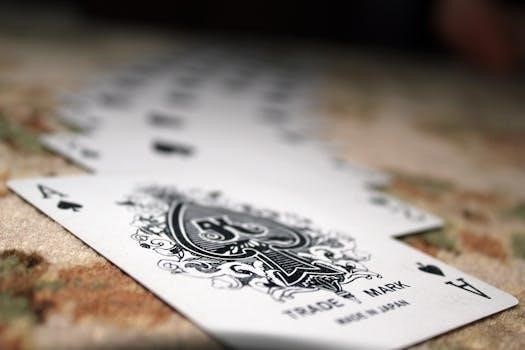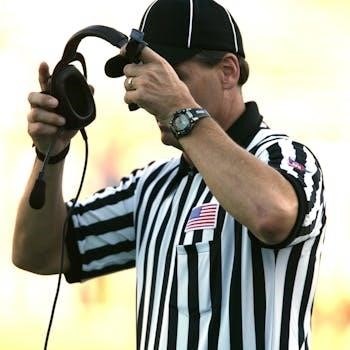Hand and Foot Card Game Rules Overview
The card game Hand and Foot is a variation of Canasta, typically played in teams, aiming to be the first to reach a set score by melding cards․ It uses multiple decks, with the objective to get rid of cards from both the hand and foot by creating melds․
Hand and Foot is a captivating card game, often likened to Canasta but with a unique twist, involving both a “hand” and a “foot” of cards for each player․ This strategic game requires players to form melds, or sets, of matching cards to score points and ultimately go out․ It’s typically played with multiple decks of cards, depending on the number of players, and encourages both individual skill and teamwork․ The game’s popularity stems from its blend of straightforward rules and the opportunity for strategic card play․ The rules may vary slightly depending on the group, with some opting for specific “house rules” to further customize the gameplay․ Its engaging nature makes it a favorite for card game enthusiasts․ It involves drawing, discarding, and melding, making each turn a new opportunity to win the round․
Basic Gameplay and Objective
The core gameplay of Hand and Foot revolves around each player or team attempting to be the first to get rid of all their cards from their “hand” and then their “foot” by melding them onto the table․ A meld is a set of three to seven cards of the same rank, placed face-up, and belonging to the team, not the individual․ The objective is to score points by forming these melds and completing “books,” which are a specific number of cards of the same rank․ Players draw, discard, and strategically add cards to melds․ The game continues until a team goes out, typically achieved by completing a certain amount of clean and dirty books․ Scoring varies based on the cards and books completed․

Card Game Setup
To begin, gather the necessary decks, typically one more than the number of players․ Each player is then dealt two sets of cards, forming the hand and foot piles, to prepare for game play․
Number of Players and Decks
Hand and Foot is a flexible card game, accommodating anywhere from two to six players, though it’s most commonly played with four participants in two teams․ The game requires multiple decks of standard playing cards, including the jokers․ The precise number of decks depends on the player count; generally, you’ll need one more deck than the number of people playing․ For instance, a four-player game would use five decks, and a six-player game would use seven decks․ These decks are shuffled together to form a single draw pile that is used to deal the hand and foot for each player․ This setup ensures there are sufficient cards for the game’s various rounds and melds, allowing for a smoother and more strategic playing experience․ Using the correct number of decks based on the player count is a crucial step in setting up a proper game of Hand and Foot․
Dealing the Hand and Foot
The process of dealing in Hand and Foot is unique, as each player receives two separate piles of cards⁚ the hand and the foot․ To begin, after the decks have been shuffled, each player is dealt a specified number of cards, usually 22, which are then divided into two piles․ The first pile, the “hand,” typically consists of 11 cards, which are held in the player’s hand․ The second pile, the “foot,” also has 11 cards and is placed face down in front of the player․ The hand is played first, and only after all cards from the hand have been melded or discarded, can the player pick up and begin playing with the foot․ This two-pile system adds an extra layer of strategy․ The initial dealing sets the stage for the game, with the hand offering immediate playing options, and the foot providing a reserve of cards to be used later․

Playing the Game
During gameplay, players draw cards, discard, and create melds of same-rank cards․ The game continues until a player has exhausted their hand and foot by going out, which also requires completing specific book requirements․
Turns⁚ Drawing and Discarding
Each player’s turn begins with drawing two cards from the draw pile․ After drawing, the player must choose one card to discard, placing it face-up onto the discard pile․ This cycle of drawing and discarding is fundamental to the game, allowing players to strategically acquire cards that will help them form melds․ The goal is to improve their hand while preventing opponents from benefitting from the discarded cards․ This action forms the basis of the game flow, with the constant cycle of drawing and discarding shaping the progression of the game․ Players need to carefully evaluate which cards to keep and which to discard, as this choice can have a significant impact on their ability to form books and ultimately go out․ The drawing and discarding phase requires careful consideration and a strategic approach to maximize the chances of success․ The discarded card is then open for other players to pick up, adding a layer of complexity to the gameplay․
Melding Cards and Forming Books
Melding in Hand and Foot involves placing groups of three to seven cards of the same rank face-up on the table․ These groups are known as “books” and are essential for accumulating points․ A meld belongs to the team, not any individual player․ Players aim to create multiple books throughout the game, and strategic melding is crucial for success․ Once a player starts a book, they can add matching cards to it on subsequent turns․ However, a book cannot contain more than seven cards․ The books are categorized as “clean” or “dirty,” with different rules and point values associated with each․ Players must focus on forming books to empty their hands and later, their foot․ Effective melding is a cornerstone of the game, requiring careful planning and awareness of the cards in play․
Going Out and Picking Up the Foot
A player “goes out” when they have played all the cards from their hand, either by melding them into books or discarding them․ Once a player goes out, they then get to pick up their “foot,” which is the second set of cards they were initially dealt․ The foot is then played using the same rules as the hand․ The requirement for going out typically includes completing a specific number of clean and dirty books․ Furthermore, some variations require a “wild pile” of seven cards to be completed․ The ability to go out and pick up the foot is a critical step in the game, allowing players to continue building books and scoring points․ A strategic focus on melding and completing the necessary books is needed to go out effectively․

Special Rules and Variations
Hand and Foot has several variations, including rules for clean and dirty books, the use of wild cards, and alternate house rules which offer flexibility in gameplay․ These adjustments can significantly alter the game’s strategy․
Clean and Dirty Books
In Hand and Foot, the concept of “clean” and “dirty” books adds a layer of strategy to the game․ A clean book consists of seven cards of the same rank, without any wild cards included, making it a more valuable meld․ Conversely, a dirty book also contains seven cards of the same rank, but it includes one or more wild cards like jokers or twos․ The distinction between clean and dirty books is crucial, as completing a required number of each type of book is often necessary for a team to go out and pick up their foot․ The topmost card of a completed book will be red for clean and black for dirty․ The specific requirements for clean and dirty books can vary slightly depending on the house rules being used, so it’s essential to clarify these rules before starting the game․ These rules significantly affect the game’s scoring and overall objective․
Wild Cards and Their Usage
Wild cards, typically twos and jokers, play a vital role in Hand and Foot, acting as substitutes for any other card rank to assist in forming melds or books․ They provide flexibility to players, enabling them to complete sets of cards more easily․ However, there are specific rules regarding their use․ Wild cards can be used in any book as a substitute, however, clean books will not contain any wild cards․ A book with a wild card is considered a dirty book․ In addition, wild cards are sometimes required for a team to go out and pick up their foot, which adds to the strategic importance of their usage․ Understanding how and when to use wild cards is essential for successful gameplay, as using them strategically can significantly impact the outcome․ They are also important for the scoring system․
Alternate House Rules
Hand and Foot, while having general guidelines, is often subject to various house rules that can alter gameplay significantly․ These variations can range from the number of cards dealt initially to specific requirements for going out or picking up the foot․ Some groups may choose to adjust the point values for different books or even how wild cards are used, making each game unique․ Some examples might include changing the number of clean and dirty books required to go out or the number of cards needed to pick up the foot, or even the point values of the cards at the end of the game․ The beauty of Hand and Foot lies in its adaptability, allowing players to customize rules for more enjoyment and a challenging experience․ It’s always a good idea to agree on house rules before the start of the game․

Resources and Downloads
Numerous online resources offer free, printable PDF rule sheets for Hand and Foot, which can be easily found through websites dedicated to card games and gaming forums, along with scoring sheets and cheat sheets․
Finding Printable PDF Rules
Locating printable PDF rules for the Hand and Foot card game is quite straightforward, thanks to the abundance of online resources․ Many websites dedicated to card games, as well as various gaming forums, host these downloadable guides․ To find them, simply use search terms like “Hand and Foot rules PDF” or “printable Hand and Foot rules” in your preferred search engine․ These searches will generally lead you to sites offering free PDF documents․ These PDF files typically include detailed instructions on gameplay, scoring, and special rules variations, ensuring that both beginners and experienced players have a quick reference․ Additionally, some resources may also provide cheat sheets and scoring templates, which are beneficial for organizing game nights․ Therefore, accessing these readily available materials can greatly enhance your Hand and Foot gaming experience, providing all the necessary information at your fingertips․
Online Resources for Hand and Foot
The internet offers numerous online resources for the Hand and Foot card game, making it easy to learn and play․ Beyond just printable PDF rule guides, many websites and forums offer dedicated pages with interactive tutorials, videos, and community discussions․ These resources often provide visual aids, like diagrams and gameplay examples, helping players understand the rules more clearly․ Some online platforms host virtual Hand and Foot games where you can practice against computer opponents or other players․ Online communities also provide a space to ask questions, share strategies, and discuss house rule variations․ Furthermore, certain websites may feature tools such as score trackers or rule modification suggestions․ This broad range of online resources ensures that players of any level can find the help and support they need to engage with the game effectively, making the experience more accessible and enjoyable․